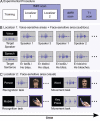Direct structural connections between voice- and face-recognition areas
- PMID: 21900569
- PMCID: PMC6623403
- DOI: 10.1523/JNEUROSCI.2091-11.2011
Direct structural connections between voice- and face-recognition areas
Abstract
Currently, there are two opposing models for how voice and face information is integrated in the human brain to recognize person identity. The conventional model assumes that voice and face information is only combined at a supramodal stage (Bruce and Young, 1986; Burton et al., 1990; Ellis et al., 1997). An alternative model posits that areas encoding voice and face information also interact directly and that this direct interaction is behaviorally relevant for optimizing person recognition (von Kriegstein et al., 2005; von Kriegstein and Giraud, 2006). To disambiguate between the two different models, we tested for evidence of direct structural connections between voice- and face-processing cortical areas by combining functional and diffusion magnetic resonance imaging. We localized, at the individual subject level, three voice-sensitive areas in anterior, middle, and posterior superior temporal sulcus (STS) and face-sensitive areas in the fusiform gyrus [fusiform face area (FFA)]. Using probabilistic tractography, we show evidence that the FFA is structurally connected with voice-sensitive areas in STS. In particular, our results suggest that the FFA is more strongly connected to middle and anterior than to posterior areas of the voice-sensitive STS. This specific structural connectivity pattern indicates that direct links between face- and voice-recognition areas could be used to optimize human person recognition.
Conflict of interest statement
The authors declare no conflict of interest.
Figures





Similar articles
-
Voice recognition and the posterior cingulate: an fMRI study of prosopagnosia.J Neuropsychol. 2008 Mar;2(1):269-86. doi: 10.1348/174866407x246131. J Neuropsychol. 2008. PMID: 19334314
-
How the human brain exchanges information across sensory modalities to recognize other people.Hum Brain Mapp. 2015 Jan;36(1):324-39. doi: 10.1002/hbm.22631. Epub 2014 Sep 13. Hum Brain Mapp. 2015. PMID: 25220190 Free PMC article.
-
Activation in the angular gyrus and in the pSTS is modulated by face primes during voice recognition.Hum Brain Mapp. 2017 May;38(5):2553-2565. doi: 10.1002/hbm.23540. Epub 2017 Feb 20. Hum Brain Mapp. 2017. PMID: 28218433 Free PMC article.
-
The anterior fusiform gyrus: The ghost in the cortical face machine.Neurosci Biobehav Rev. 2024 Mar;158:105535. doi: 10.1016/j.neubiorev.2024.105535. Epub 2024 Jan 6. Neurosci Biobehav Rev. 2024. PMID: 38191080 Review.
-
Face processing in the temporal lobe.Handb Clin Neurol. 2022;187:191-210. doi: 10.1016/B978-0-12-823493-8.00019-5. Handb Clin Neurol. 2022. PMID: 35964972 Review.
Cited by
-
The modulatory effect of semantic familiarity on the audiovisual integration of face-name pairs.Hum Brain Mapp. 2016 Dec;37(12):4333-4348. doi: 10.1002/hbm.23312. Epub 2016 Jul 12. Hum Brain Mapp. 2016. PMID: 27401122 Free PMC article.
-
Exploring the cerebral substrate of voice perception in primate brains.Philos Trans R Soc Lond B Biol Sci. 2020 Jan 6;375(1789):20180386. doi: 10.1098/rstb.2018.0386. Epub 2019 Nov 18. Philos Trans R Soc Lond B Biol Sci. 2020. PMID: 31735143 Free PMC article. Review.
-
Anatomical connections of the visual word form area.J Neurosci. 2014 Nov 12;34(46):15402-14. doi: 10.1523/JNEUROSCI.4918-13.2014. J Neurosci. 2014. PMID: 25392507 Free PMC article.
-
Brain systems mediating voice identity processing in blind humans.Hum Brain Mapp. 2014 Sep;35(9):4607-19. doi: 10.1002/hbm.22498. Epub 2014 Mar 17. Hum Brain Mapp. 2014. PMID: 24639401 Free PMC article.
-
Structural and effective connectivity reveals potential network-based influences on category-sensitive visual areas.Front Hum Neurosci. 2015 May 7;9:253. doi: 10.3389/fnhum.2015.00253. eCollection 2015. Front Hum Neurosci. 2015. PMID: 25999841 Free PMC article. Review.
References
-
- Andics A, McQueen JM, Petersson KM, Gál V, Rudas G, Vidnyánszky Z. Neural mechanisms for voice recognition. Neuroimage. 2010;52:1528–1540. - PubMed
-
- Anwander A, Tittgemeyer M, von Cramon DY, Friederici AD, Knösche TR. Connectivity-based parcellation of Broca's area. Cereb Cortex. 2007;17:816–825. - PubMed
-
- Basser PJ, Pierpaoli C. Microstructural and physiological features of tissues elucidated by quantitative-diffusion-tensor MRI. J Magn Reson B. 1996;111:209–219. - PubMed
-
- Basser PJ, Mattiello J, LeBihan D. Estimation of the effective self-diffusion tensor from the NMR spin-echo. J Magn Reson B. 1994;103:247–254. - PubMed
Publication types
MeSH terms
LinkOut - more resources
Full Text Sources
Other Literature Sources
